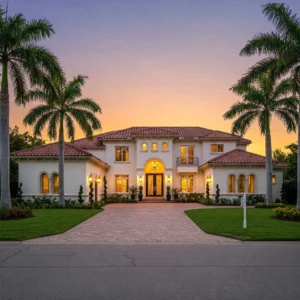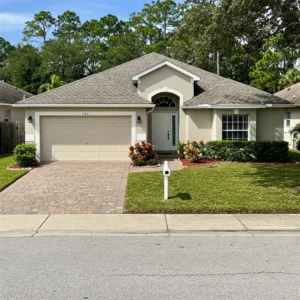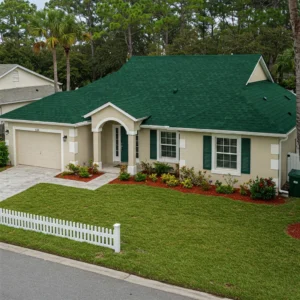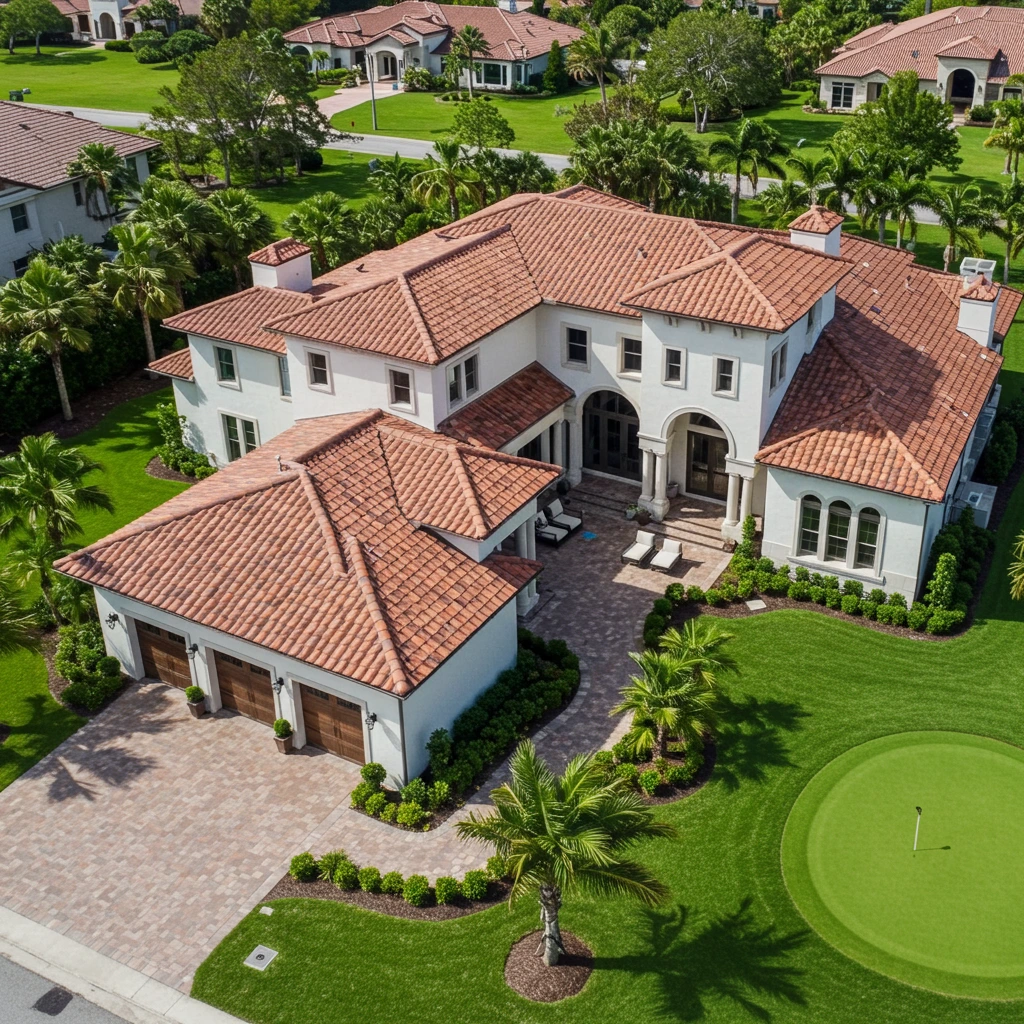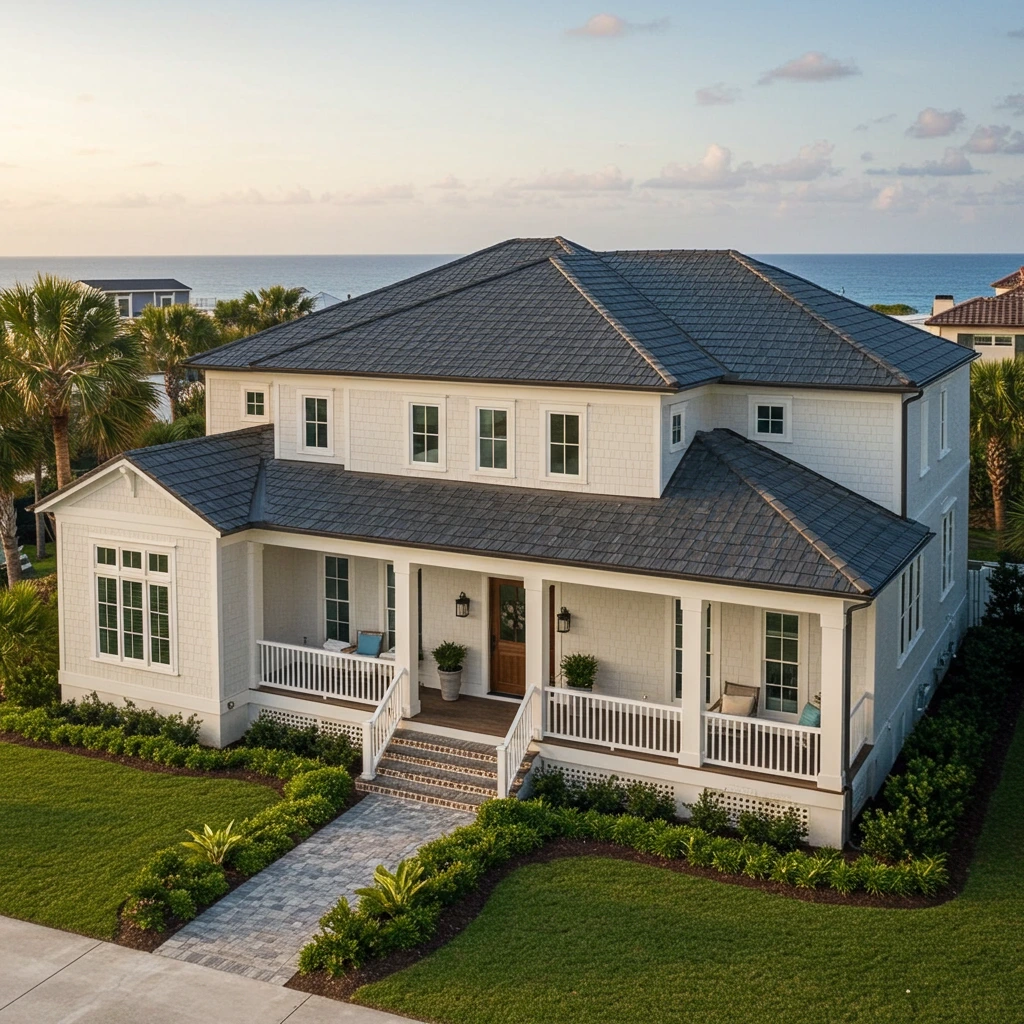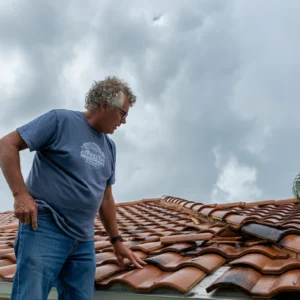
Delray Roof Care: Pro Guide to a Lasting South Florida Roof
Published on by Ron Bell Roofing. Reading time: Approx. 15-20 minutes.
Understanding Your South Florida Roof: Climate Challenges & Common Materials
Living in Delray Beach and the broader South Florida region means embracing a beautiful tropical lifestyle, but it also means recognizing the specific challenges our climate poses to roofing structures. Understanding these factors and the common roofing materials best suited to withstand them is the first step in effective roof care.The South Florida Climate Gauntlet:
- Intense UV Radiation: The relentless Florida sun beats down on roofs year-round. This constant exposure to ultraviolet (UV) rays can accelerate the degradation of many roofing materials. Asphalt shingles can become brittle and lose their protective granules, sealants can dry out and crack, and even tile or metal surfaces can experience fading or material stress over time. Long-term sun exposure and roofing material degradation is a key concern.
- High Humidity & Moisture: Our tropical climate is characterized by high humidity levels. This persistent moisture creates an ideal breeding ground for mold, mildew, and algae, especially on shaded or poorly ventilated roof areas. These growths aren’t just unsightly; they can trap moisture against the roof surface, leading to rot, deterioration of underlayment, and even leaks.
- Heavy Rainfall: South Florida experiences significant rainfall, particularly during the rainy season (roughly May through October) and from tropical systems. Roofs must be able to efficiently shed large volumes of water. Any deficiencies in flashing, sealing, or drainage systems can quickly lead to water intrusion.
- Hurricane Threats: Hurricane season (June 1st to November 30th) is a major concern. High winds can lift and remove shingles or tiles, damage flashing, and hurl debris that can puncture roofing materials. Wind-driven rain can also force water into vulnerable areas of the roof that might otherwise remain sealed. Proper hurricane roof protection Delray Beach is non-negotiable.
- Salt Air Corrosion: For properties near the coast, like many in Delray Beach, salt-laden air can accelerate the corrosion of metal roofing components, including flashing, fasteners, and even some metal roofing panels if not properly treated or selected.
Common Roofing Materials in Delray Beach and Their Characteristics:
- Tile Roofs (Concrete & Clay): Very popular in South Florida for their durability, aesthetic appeal, and resistance to fire and insects. Tiles can last 50+ years with proper maintenance. They perform well against high winds when correctly installed. However, individual tiles can crack or dislodge, and the underlayment beneath them is critical and will eventually need replacement. Tile roof maintenance South Florida often involves checking for cracked or slipped tiles and ensuring the underlayment’s integrity.
- Asphalt Shingles: A cost-effective and versatile option. Architectural shingles offer better wind resistance and longevity (20-30 years) than older 3-tab shingles. However, they are more susceptible to UV degradation, algae growth (look for algae-resistant shingles), and damage from high winds if not properly installed or if they are nearing the end of their lifespan.
- Metal Roofs (Aluminum, Steel, Copper): Increasingly popular for their exceptional durability, longevity (50+ years), energy efficiency (reflecting solar heat), and high wind resistance. Aluminum is particularly well-suited for coastal areas due to its corrosion resistance. Proper installation and quality coatings are key.
- Flat Roofs (Modified Bitumen, TPO, EPDM): Common for commercial buildings and some residential designs. They require robust waterproofing systems and positive drainage to prevent ponding water, which is a primary cause of flat roof failure. Flat roof care in Florida climate focuses on membrane integrity and drainage.
The Ron Bell Roofing Regular Maintenance Checklist: Proactive Roof Care Saves Money
Proactive roof care is the most effective way to prevent minor issues from escalating into major, costly problems. Think of it like regular health check-ups for your roof. For Delray Beach property owners, a consistent maintenance routine tailored to our South Florida climate can significantly extend your roof’s lifespan and save you considerable expense and stress in the long run. At Ron Bell Roofing, we recommend a two-pronged approach: diligent DIY observations and periodic professional inspections.Your DIY Visual Inspection Routine (Recommended Seasonally & After Storms):
Safety First! Never walk on a wet or steep roof. Use binoculars from the ground or a secure ladder position for these checks.- Ground-Level Walk-Around:
- Look for any loose, cracked, or missing shingles or tiles.
- Check for shingle granules in your gutters or on the ground around your downspouts – this indicates shingle wear.
- Examine soffits and fascia for signs of rot, pest intrusion, or water stains.
- Note any sagging areas on the roofline, which could indicate structural issues. Identifying roof sagging causes early is crucial.
- Gutter and Downspout Check:
- Ensure gutters are clear of leaves, branches, and other debris. Clogged gutters are a leading cause of water backing up under roofing materials and damaging fascia boards. Importance of clean gutters Delray Beach cannot be overstated.
- Verify that downspouts are securely attached and directing water away from the foundation.
- Interior Check (Attic/Crawl Space):
- Look for any signs of water stains on the underside of the roof deck or on insulation.
- Check for dampness or musty odors, which can indicate leaks or poor ventilation.
- Note any daylight visible through the roof boards (a clear sign of a breach).
- Flashing and Sealant Points:
- Visually inspect (from a safe vantage point) the flashing around chimneys, vents, skylights, and other roof penetrations. Look for signs of rust, lifting, or missing sealant. Damaged flashing is a common source of leaks.
- Vegetation Management:
- Trim overhanging tree branches that could rub against the roof surface or fall during a storm, causing damage.
- Remove any debris (leaves, twigs) that has accumulated on the roof surface, as this can trap moisture.
When to Call Ron Bell Roofing for Professional Maintenance & Inspection:
While DIY checks are helpful, they don’t replace the expertise of a seasoned professional. We recommend a professional inspection:- Annually: A yearly check-up can catch developing issues you might miss.
- After Severe Weather Events: Following a hurricane, tropical storm, or significant hailstorm, a professional eye can assess for hidden damage.
- If You Suspect a Problem: If your DIY checks reveal any concerns, or if you notice leaks or other issues, call us immediately. Delray Beach roof leak detection and repair is one of our specialties.
- When Buying or Selling a Property: A roof inspection provides crucial information for both parties.
Common Roof Problems in Delray Beach & How We Address Them
Despite diligent roof care, the harsh South Florida environment means that residential and commercial property owners in Delray Beach will inevitably encounter roof problems. Recognizing the signs early and understanding the common culprits can help you take swift action. Ron Bell Roofing has seen it all in our 38+ years, and here are some of the most frequent issues we tackle:1. Roof Leaks:
- Signs: Water stains on ceilings or walls, damp spots around vents or fireplaces, musty odors in the attic, dripping water.
- Common Causes in South Florida: Damaged/missing shingles or tiles, compromised flashing (especially around chimneys, vents, and skylights), cracked or deteriorated sealants, and underlayment failure. Finding hidden roof leaks South Florida often requires professional expertise.
- Ron Bell Roofing’s Approach: We don’t just patch the symptom; we perform thorough leak detection to find the true source. This may involve water testing and careful examination of all vulnerable areas. Repairs are made using quality materials designed to integrate with your existing roof and withstand local conditions.
2. Damaged or Missing Shingles/Tiles:
- Signs: Visible gaps on the roof, shingles/tiles on the ground after a storm, curled or cracked shingles, broken tiles.
- Common Causes in South Florida: High winds (especially during hurricane season), falling debris, foot traffic (improperly done), and age-related wear and tear. UV exposure makes shingles brittle over time.
- Ron Bell Roofing’s Approach: We carefully match and replace damaged or missing units. For shingles, we ensure proper nailing patterns and sealing. For tiles, we check the underlayment and ensure the new tile is correctly set and secured. Addressing wind damage roof repair Delray Beach promptly is key to preventing further water intrusion.
3. Flashing Failures:
- Signs: Leaks around chimneys, vents, skylights, or where roof planes meet (valleys). Visible rust, corrosion, or lifting of metal flashing.
- Common Causes in South Florida: Improper installation, age, corrosion (especially from salt air), and sealant deterioration due to UV exposure and temperature fluctuations.
- Ron Bell Roofing’s Approach: We assess if the flashing can be repaired and resealed or if replacement is necessary. We use high-quality, corrosion-resistant flashing materials and ensure they are installed to create a watertight seal.
4. Gutter Issues & Poor Drainage:
- Signs: Clogged gutters, water overflowing from gutters, water pooling near the foundation, erosion around downspouts, damaged fascia boards.
- Common Causes in South Florida: Abundant foliage leading to debris accumulation, improper gutter slope, insufficient downspouts, or damaged gutter sections.
- Ron Bell Roofing’s Approach: While we primarily focus on roofing, we understand the integral role gutters play. We can clear minor clogs during maintenance and advise on necessary gutter repairs or replacement, often coordinating with trusted gutter specialists. Ensuring proper roof drainage solutions Florida is vital.
5. Mold, Mildew, and Algae Growth:
- Signs: Dark streaks or discolored patches on the roof surface.
- Common Causes in South Florida: High humidity, shade, and trapped moisture provide an ideal environment for these organisms.
- Ron Bell Roofing’s Approach: We can advise on safe cleaning methods (low-pressure washing with appropriate solutions). For prevention, we may recommend algae-resistant shingles or zinc strips. Proper attic ventilation also helps reduce moisture buildup that encourages growth.
6. Ponding Water (Flat Roofs):
- Signs: Areas of standing water on a flat roof 48 hours after rain.
- Common Causes in South Florida: Improper slope/drainage, clogged drains, or structural sagging.
- Ron Bell Roofing’s Approach: This is a serious issue that can lead to rapid deterioration. We assess the cause and may recommend creating proper slope with tapered insulation, clearing or adding drains, or repairing the membrane.
Hurricane Season Preparedness: Fortifying Your Delray Beach Roof
For Delray Beach and all South Florida property owners, hurricane season (June 1st – November 30th) demands special attention to roof care. Your roof is the primary shield against high winds and torrential rain. Taking proactive steps to prepare can significantly reduce the risk of severe damage and costly repairs. Ron Bell Roofing has helped countless clients weather these storms, and we emphasize that early preparation is key to hurricane roof safety.Essential Pre-Hurricane Season Roof Checklist:
- Professional Roof Inspection (Early Spring is Ideal): This is the most crucial step. A Ron Bell Roofing professional can identify and address vulnerabilities before a storm is imminent. We look for loose or damaged shingles/tiles, compromised flashing, weak points in the roof deck, and the condition of roof-to-wall connections. Pre-hurricane roof inspection Delray Beach can provide critical lead time for repairs.
- Make Necessary Repairs Promptly: Don’t delay any recommended repairs. Loose shingles can become projectiles in high winds. Unsealed flashing is an open invitation for wind-driven rain. Even minor issues can be exacerbated by hurricane-force conditions.
- Secure or Reinforce Roofing Materials: Ensure shingles are well-adhered. For tile roofs, check for loose or cracked tiles. Consider options like hurricane straps or clips, which improve the connection between your roof structure and the walls of your building. While often installed during construction or re-roofing, retrofitting can sometimes be possible. In some cases, applying roofing cement to the edges of shingles can offer additional protection, but this should be done carefully and professionally to avoid damaging the shingles or voiding warranties.
- Inspect and Clear Gutters & Downspouts: Gutters filled with debris will cause water to back up onto the roof and potentially under the roofing material, especially with heavy hurricane rains. Ensure downspouts are clear and directing water well away from the building.
- Trim Trees and Secure Loose Outdoor Items: Overhanging branches can break and fall onto your roof during high winds. Keep trees trimmed well back from your home or commercial building. Secure or bring inside any loose items in your yard (patio furniture, trampolines, decorations) that could become airborne projectiles and damage your roof or property.
- Check Your Attic Ventilation: Proper ventilation can help reduce pressure differences that can cause roofs to lift during high winds. Ensure vents are not blocked.
- Review Your Insurance Policy: Understand your hurricane deductible and what types of roof damage are covered. Keep photos of your roof’s pre-storm condition for documentation. Understanding homeowners insurance roof coverage Florida is vital.
- Have Emergency Supplies Ready: If minor damage occurs, having tarps and basic supplies on hand can help you temporarily mitigate further water intrusion until professional repairs can be made.
Choosing a Delray Beach Roofing Contractor: Why Ron Bell Roofing Stands Out
When it comes to roof care, repairs, or replacement in Delray Beach, selecting the right roofing contractor is paramount. Your roof is a significant investment, and you need a company that is experienced, reliable, and understands the unique demands of the South Florida climate. Ron Bell Roofing has been serving the Delray Beach community and surrounding areas for over 38 years, building a reputation for quality workmanship and customer satisfaction.Key Factors to Consider When Hiring a Roofer in Delray Beach:
- Licensing and Insurance (The Non-Negotiables):
- Florida State License: Ensure any contractor you consider holds a valid Florida Certified Roofing Contractor license. You can verify this on the Florida Department of Business and Professional Regulation (DBPR) website. Ron Bell Roofing is fully licensed (License #CCC036823).
- General Liability Insurance: This protects your property in case of accidental damage during the roofing project.
- Workers’ Compensation Insurance: This covers the contractor’s employees if they are injured on your property, protecting you from liability. Always ask for current certificates of insurance.
- Local Experience and Reputation:
- Years in Business Locally: A contractor with a long history in Delray Beach, like Ron Bell Roofing, understands local building codes, climate challenges (hurricanes, humidity, sun), and common roofing issues specific to our area. Benefits of local Delray Beach roofers include familiarity with permitting processes and supplier networks.
- References and Reviews: Ask for references from recent local projects. Check online reviews on platforms like Google, Yelp, and the Better Business Bureau (BBB).
- Detailed Written Estimates and Contracts:
- Never rely on a verbal quote. A professional contractor will provide a detailed written estimate outlining the scope of work, materials to be used (brand, type, color), labor costs, payment schedule, and estimated start and completion dates.
- The contract should clearly state warranty information for both materials and workmanship.
- Knowledge of Roofing Materials and Systems:
- The contractor should be knowledgeable about various roofing types (tile, shingle, metal, flat) and be able to recommend the best options for your specific property, budget, and South Florida’s climate.
- Communication and Professionalism:
- Choose a contractor who communicates clearly, answers your questions thoroughly, and addresses any concerns promptly. Professionalism should be evident from the first contact through project completion.
- Workmanship Warranty:
- Material warranties are provided by the manufacturer, but your contractor should offer a separate warranty on their workmanship. This shows they stand behind the quality of their installation or repair. Ron Bell Roofing provides robust workmanship warranties.
Ron Bell Roofing’s Commitment to Delray Beach Property Owners:
Our unique insight isn’t just about technical skill; it’s about our deep roots in the community. We’ve seen firsthand the devastation that poorly installed or maintained roofs can suffer during South Florida’s storms. That’s why we emphasize not just doing the job, but doing it right according to the highest industry standards and Florida’s stringent building codes. We live here too, and our reputation is built on the long-term performance of the roofs we install and service. We believe in educating our clients about their roof care options, providing transparent pricing, and delivering durable, reliable roofing solutions. When you choose Ron Bell Roofing, you’re choosing a partner dedicated to protecting your Delray Beach property. Learn more about us.The Financial Side of Roof Care: Inspections, Repairs, and Replacement Costs in Delray Beach
Investing in proper roof care is not just about maintaining the integrity of your property; it’s also a significant financial consideration for Delray Beach homeowners and commercial property managers. Understanding the potential costs associated with inspections, repairs, and eventual replacement can help you budget effectively and make informed decisions. While prices can vary based on numerous factors, here’s a general guide to what you might expect in the South Florida market.Cost of Roof Inspections:
A professional roof inspection is a relatively low-cost preventative measure that can save you thousands in the long run.- Typical Range in Delray Beach: For a standard residential roof, inspections might range from $100 to $400. Commercial inspections or more complex residential roofs could be higher.
- What’s Included: A thorough visual examination of the roof surface, flashing, gutters, chimneys, vents, and often the attic space. You should receive a detailed written report with findings and recommendations. Ron Bell Roofing often offers free estimates for repairs, which naturally include an inspection component if a problem is suspected. Affordable roof inspection Delray Beach can be found, but prioritize thoroughness over the cheapest option.
Cost of Roof Repairs:
Repair costs can vary dramatically based on the extent of the damage, the type of roofing material, and the complexity of the job.- Minor Repairs: Replacing a few missing shingles or sealing a small leak around flashing might cost anywhere from $200 to $700.
- Moderate Repairs: Addressing larger areas of damaged shingles, repairing significant flashing issues, or fixing sections of underlayment could range from $700 to $2,500 or more.
- Factors Influencing Repair Costs:
- Material Type: Tile roof repairs are often more expensive than shingle repairs due to material cost and labor intensity. Metal and flat roof repairs have their own cost structures.
- Extent of Damage: The larger the affected area, the higher the cost.
- Accessibility: Steep roofs or those with difficult access can increase labor costs.
- Underlying Damage: If a leak has caused damage to the roof deck or insulation, those repairs will add to the overall cost. Cost to fix roof leak South Florida depends heavily on these factors.
Cost of Roof Replacement (Re-Roofing):
This is a major investment, typically required every 20-50+ years depending on the material and maintenance.- Average Range in Delray Beach (per square foot):
- Asphalt Shingles: $4.50 – $7.00+ per sq. ft.
- Tile (Concrete/Clay): $9.00 – $18.00+ per sq. ft.
- Metal Roofs: $8.00 – $20.00+ per sq. ft.
- Flat Roofs: $6.00 – $12.00+ per sq. ft.
- Total Project Costs: For an average-sized home (e.g., 1,500-2,500 sq. ft. of roofing area), this can translate to:
- Asphalt Shingles: $7,000 – $17,500+
- Tile: $13,500 – $45,000+
- Metal: $12,000 – $50,000+
- Factors Influencing Replacement Costs: Roof size, pitch complexity, material choice, tear-off of old roofing layers, underlayment type, and any necessary decking repairs.
Ron Bell Roofing’s Unique Perspective on Value:
While cost is always a factor, the value you receive is paramount. A cheaper bid might mean lower quality materials, rushed workmanship, or inadequate insurance, leading to more problems and higher costs down the line. Ron Bell Roofing provides transparent, detailed estimates, uses quality materials, and adheres to best installation practices. We believe that excellent roof care and professional services offer the best long-term financial protection for your Delray Beach property by maximizing your roof’s lifespan and minimizing unexpected, costly emergencies. Investing in long-lasting roofing solutions Delray Beach is always more economical over time.1. Anatomy of a South Florida Roof: Key Care Points
Description: A clear, cross-section diagram of a typical South Florida sloped roof (e.g., tiled or shingle). Callouts would highlight key components and common problem areas relevant to roof care.- Shingles/Tiles (note UV exposure, potential for cracks/lifting)
- Underlayment (emphasize its role as a secondary water barrier)
- Flashing (around chimney, vents, valleys – “Prime Leak Zones”)
- Gutters (show debris and proper water flow away from the house)
- Soffit/Fascia (potential for rot/water damage)
- Attic Ventilation (arrows showing airflow to reduce heat/moisture)
2. South Florida Roof Care Calendar: Seasonal Checklist
Description: An infographic designed as a yearly calendar, divided into seasons or key periods (e.g., Pre-Hurricane Season, End of Hurricane Season, Dry Season). Each section would list 2-3 top roof care tasks for Delray Beach property owners.- Spring (March-May / Pre-Hurricane Prep): “Schedule Professional Inspection,” “Clear Gutters & Drains,” “Trim Overhanging Trees.”
- Summer (June-August / Hurricane Season & Heavy Rains): “Monitor for Leaks After Storms,” “Ensure Downspouts Functioning,” “Secure Loose Yard Items.”
- Fall (September-November / End of Hurricane Season): “Post-Storm Inspection (DIY & Professional if needed),” “Clear Fall Debris from Gutters,” “Check Seals Around Vents/Flashing.”
- Winter (December-February / Drier Season): “Visual Check for Wear & Tear,” “Address Minor Repairs,” “Plan for Major Work if Needed.”
3. Warning Signs Your Delray Beach Roof Needs Professional Care
Conclusion: Partner with Ron Bell Roofing for Lasting Delray Beach Roof Protection
Your roof is more than just a covering; it’s a complex system that diligently protects your Delray Beach home or business, your assets, and your peace of mind from South Florida’s demanding climate. Throughout this guide, we’ve emphasized that consistent, proactive roof care is not merely an expense but a crucial investment in the longevity and structural integrity of your property. From understanding the unique challenges posed by our intense sun, humidity, and hurricane seasons, to recognizing the early warning signs of common roof problems, knowledge empowers you to make informed decisions. Regular inspections, diligent maintenance like keeping gutters clear and trimming overhanging trees, and timely professional repairs are the cornerstones of extending your roof’s life and avoiding the significant costs and disruptions associated with premature roof failure. Preparing for hurricane season is not an option but a necessity in our region, and a well-maintained roof is your best first defense. For over 38 years, Ron Bell Roofing has been dedicated to providing Delray Beach and the wider South Florida community with expert roofing services. We understand the local environment, the best materials for our climate, and the importance of quality workmanship. Don’t wait for a small issue to become a major headache. Take action today to protect your investment. Call Ron Bell Roofing: (561) 737-7507 Get Your Free Estimate Online Let us partner with you to ensure your roof remains strong, secure, and beautiful for years to come.Frequently Asked Questions (FAQs) about South Florida Roof Care
Q1: How often should I really have my Delray Beach roof professionally inspected?
A1: We recommend a professional inspection by a qualified contractor like Ron Bell Roofing at least once a year. Additionally, it’s wise to get an inspection after any major weather event, such as a hurricane or severe hailstorm, even if you don’t see obvious damage. This proactive approach helps in early detection of roof damage South Florida and can prevent small issues from becoming costly repairs.Q2: What are the most common signs of a roof leak I should look for inside my home?
A2: The most common interior signs include unexplained water stains on ceilings or walls (often yellowish or brownish), peeling paint near rooflines, damp spots around vents or skylights, and a persistent musty odor, particularly in your attic or upper floors. Addressing these signs quickly is key for effective Delray Beach residential roof repair.Q3: Are tile roofs really better than shingles for the South Florida climate?
A3: Both tile and high-quality architectural shingles can perform well in South Florida if properly installed and maintained. Tile roofs generally offer superior longevity (50+ years) and wind resistance. However, modern architectural shingles offer good durability (20-30 years) and can be more budget-friendly upfront. The “best” choice depends on your budget, aesthetic preference, and long-term goals. We can discuss comparing tile vs shingle roofs Florida benefits during a consultation.Q4: How can I tell if my roof has been damaged after a hurricane if I don’t see missing shingles?
A4: Hurricane damage isn’t always obvious from the ground. Look for lifted shingles (edges no longer sealed down), creased shingles, impact marks from debris (dents or cracks), damaged flashing, or an accumulation of shingle granules in gutters. A professional inspection is the best way to identify hidden storm damage to roofs Delray Beach to ensure no underlying issues are missed.Q5: What’s the biggest mistake homeowners make regarding roof care in South Florida?
A5: One of the biggest mistakes is delaying repairs. Ignoring small leaks or minor damage allows water intrusion, which can lead to more extensive (and expensive) problems like rotted decking, mold growth, and compromised insulation. Prompt attention to preventative roof maintenance South Florida is far more cost-effective in the long run.We Value Your Feedback!
Thank you for reading Ron Bell Roofing’s Essential South Florida Roof Care Guide! We hope you found this information valuable for protecting your Delray Beach property. We’re always striving to provide the best service and information to our community. What’s the one roof care tip you plan to implement right away? Share your thoughts in the comments section below (if your blog platform supports it) or on our social media channels! Your engagement helps us all become more informed property owners.The Impact of South Florida Weather on Roofing: A Comprehensive Analysis
Abstract
South Florida, encompassing vibrant cities like Miami, Fort Lauderdale, Boca Raton, West Palm Beach, and Delray Beach, boasts a subtropical climate characterized by warm temperatures, high humidity, and a distinct wet and dry season.
This unique weather pattern, while alluring to residents and tourists alike, poses significant challenges to building infrastructure, particularly roofing systems. This research article delves into the intricacies of South Florida's weather, analyzing its historical patterns, current trends, and future projections. It further examines the implications of these climatic conditions on roofing materials and systems, exploring the optimal timing for roof replacement, the performance of various roofing types in extreme weather events, and the long-term effects of weather exposure on roof longevity. By drawing on a comprehensive review of scientific literature, industry data, and expert insights, this study aims to provide homeowners and industry professionals with a comprehensive understanding of the complex relationship between South Florida's weather and roofing performance.1. Introduction
South Florida's climate is a defining feature of the region, attracting millions with its promise of sunshine and warmth. However, this tropical paradise is also susceptible to extreme weather events, including hurricanes, intense rainfall, and high winds.
These conditions exert significant stress on buildings, particularly their roofs, which serve as the first line of defense against the elements. The choice of roofing materials, installation techniques, and maintenance practices are therefore crucial for ensuring the structural integrity and longevity of buildings in this region.This article provides an in-depth examination of South Florida's weather patterns, focusing on the cities of Miami, Fort Lauderdale, Boca Raton, West Palm Beach, and Delray Beach. It explores the historical climate data, current trends, and future projections, taking into account the potential impacts of climate change.
Moreover, the article analyzes the implications of these weather conditions on roofing systems, offering insights into the optimal timing for roof replacement, the performance of different roofing materials in extreme weather events, and the long-term effects of weather exposure on roof durability.2. Understanding South Florida's Weather
2.1 Historical Climate Data and Current Trends
South Florida's climate is classified as subtropical, characterized by warm temperatures year-round, high humidity, and a distinct wet and dry season. The region experiences a pronounced wet season from May to October, with frequent afternoon thunderstorms and occasional tropical storms and hurricanes. The dry season, from November to April, is marked by lower humidity and generally sunny skies.
Historical climate data for South Florida reveals consistent trends of high temperatures and rainfall. Miami, for example, has an average annual temperature of around 76°F (24°C), with summer highs often exceeding 90°F (32°C) (National Weather Service, 2023). Fort Lauderdale, Boca Raton, West Palm Beach, and Delray Beach experience similar temperature ranges.
Rainfall patterns are equally consistent, with the region receiving an average annual precipitation of approximately 60 inches (152 cm), primarily during the wet season (National Weather Service, 2023).Current trends indicate a warming climate in South Florida, with both daytime and nighttime temperatures increasing steadily over the past few decades. According to the Southeast Regional Climate Center (2023), the average annual temperature in the region has increased by approximately 1.5°F (0.8°C) since the early 20th century. This warming trend is accompanied by an increase in the frequency and intensity of extreme heat events.
2.2 Future Climate Projections
Climate models project significant changes in South Florida's weather patterns in the coming decades. These projections suggest a continued warming trend, with average annual temperatures expected to increase by 3-7°F (1.7-3.9°C) by the end of the century, depending on the emissions scenario (Southeast Climate Consortium, 2022). This warming will be accompanied by more frequent and intense heat waves, posing risks to human health and infrastructure.
Rainfall patterns are also projected to change, with an increase in the intensity of extreme rainfall events. While the overall amount of annual rainfall may not change significantly, the distribution of rainfall is expected to shift, with longer dry periods punctuated by heavier downpours. This shift could lead to increased flooding and strain on drainage systems.
Sea level rise is another significant concern for South Florida. As global temperatures rise, glaciers and ice sheets melt, contributing to higher sea levels. Projections indicate that sea levels in South Florida could rise by 2-6 feet (0.6-1.8 m) by the end of the century, depending on the emissions scenario and local factors (Southeast Florida Regional Climate Change Compact, 2019). This rise in sea level will exacerbate coastal flooding, particularly during high tides and storm surges.
3. Roofing in South Florida: Challenges and Considerations
3.1 The Impact of Weather on Roofing Materials
South Florida's weather poses unique challenges to roofing systems. The combination of high temperatures, intense sunlight, humidity, and frequent heavy rainfall can significantly impact the performance and longevity of roofing materials.
High Temperatures and UV Radiation: The intense sunlight and high temperatures experienced in South Florida can cause roofing materials to degrade over time. Ultraviolet (UV) radiation from the sun can break down the chemical bonds in materials like asphalt shingles, leading to cracking, warping, and loss of waterproofing properties. High temperatures can also cause thermal expansion and contraction, which can stress the roofing system and lead to premature failure.
Humidity and Moisture: High humidity levels create a favorable environment for the growth of mold, mildew, and algae on roofing surfaces. These organisms can damage the roofing material, compromise its waterproofing capabilities, and create unsightly stains. Moisture penetration through cracks or damaged areas can also lead to leaks, water damage to the underlying structure, and the growth of mold within the building.
Heavy Rainfall and Wind: South Florida's wet season brings frequent heavy rainfall, which can test the waterproofing capabilities of roofing systems. Improperly installed or damaged roofs can allow water to penetrate the building envelope, leading to leaks, water damage, and structural problems. Strong winds associated with thunderstorms and hurricanes can also damage roofing materials, tearing off shingles, tiles, or metal panels.
Hurricanes: South Florida is particularly vulnerable to hurricanes, which can bring devastating winds, torrential rainfall, and storm surge. The high winds associated with hurricanes can cause significant damage to roofing systems, tearing off shingles, tiles, or metal panels, and even causing structural damage to the roof deck. Storm surge and flooding can further exacerbate water damage to buildings.
3.2 When to Replace Your Roof
Determining the optimal time to replace a roof is crucial for maintaining the structural integrity and protecting the investment in a home or building. In South Florida, the lifespan of a roof can vary depending on the type of material, the quality of installation, and the severity of weather exposure. However, several factors can indicate that a roof is nearing the end of its useful life:
- Age: Most roofing materials have a limited lifespan. Asphalt shingles typically last 20-30 years, while tile and metal roofs can last 50 years or more (National Roofing Contractors Association, 2023). However, these lifespans can be shortened in South Florida due to the harsh weather conditions.
- Visible Damage: Signs of wear and tear, such as cracked, curled, or missing shingles, granules in the gutters, or rust on metal roofs, indicate that the roof is deteriorating and may no longer be providing adequate protection.
- Leaks: Water stains on ceilings or walls are a clear indication of a roof leak, which can lead to significant water damage and mold growth if not addressed promptly.
- Moss or Algae Growth: Excessive moss or algae growth can indicate moisture retention and potential damage to the roofing material.
It is generally recommended to have a professional roof inspection every 2-3 years, especially after major storms, to assess the condition of the roof and identify any potential problems early on (Florida Roofing and Sheet Metal Contractors Association, 2023).
3.3 Roofing Materials Performance in Extreme Weather
The choice of roofing material is a critical decision for homeowners in South Florida, as different materials offer varying levels of performance in extreme weather events.
- Asphalt Shingles: Asphalt shingles are the most common roofing material in the United States, valued for their affordability and ease of installation. However, they are more susceptible to wind damage than other materials. In high-wind events, shingles can be lifted or torn off, leaving the underlying structure exposed to water damage. While some asphalt shingles are rated for higher wind speeds, they may still be vulnerable in hurricane-force winds.
- Tile Roofs: Clay and concrete tile roofs are popular in South Florida for their durability, aesthetic appeal, and resistance to fire and insects. They are also relatively resistant to wind damage, with some tile systems rated for wind speeds up to 150 mph (241 km/h). However, tiles can be cracked or dislodged by flying debris during hurricanes.
- Metal Roofs: Metal roofs, typically made of steel, aluminum, or copper, are known for their longevity, durability, and resistance to wind, fire, and insects. They are particularly well-suited for South Florida's climate, as they can withstand high winds and heavy rainfall. Metal roofs can be rated for wind speeds up to 180 mph (290 km/h) or higher (Metal Roofing Alliance, 2023). However, they can be susceptible to corrosion in coastal environments, particularly if not properly coated.
- Flat Roofs: Flat roofs, often used on commercial buildings, are typically covered with built-up roofing (BUR) or single-ply membranes like EPDM, TPO, or PVC. These systems can provide excellent waterproofing and durability if properly installed and maintained. However, they are susceptible to ponding water, which can lead to leaks and premature deterioration.
4. Future-Proofing Your Roof: Adapting to Climate Change
As South Florida's climate continues to evolve, it is essential to consider future weather patterns when making roofing decisions. Here are some strategies for future-proofing your roof:
- Choose Climate-Resilient Materials: Select roofing materials that are designed to withstand the projected changes in temperature, rainfall, and wind speeds. For example, consider high-wind-rated asphalt shingles, tile roofs with enhanced wind resistance, or metal roofs with corrosion-resistant coatings.
- Enhance Wind Resistance: For new roof installations or replacements, consider using enhanced wind-resistant installation techniques, such as using additional fasteners or stronger adhesives. This can help prevent wind damage during high-wind events.
- Improve Drainage: Ensure that your roof has adequate drainage to prevent ponding water, which can lead to leaks and damage. Consider installing larger gutters and downspouts to handle increased rainfall intensity.
- Regular Inspections and Maintenance: Implement a regular roof inspection and maintenance program to identify and address potential problems early on. This can help extend the lifespan of your roof and prevent costly repairs.
- Consider Cool Roofs: Cool roofs, which reflect more sunlight and absorb less heat, can help reduce the heat island effect and lower cooling costs. They can also help extend the lifespan of the roofing material by reducing thermal stress.
- Embrace Green Roofs: Green roofs, which are partially or completely covered with vegetation, can provide numerous benefits, including improved insulation, reduced stormwater runoff, and enhanced aesthetics. They can also help mitigate the urban heat island effect and improve air quality.
5. Conclusion
South Florida's unique weather presents significant challenges to roofing systems, demanding careful consideration of material selection, installation techniques, and maintenance practices. Understanding the historical climate data, current trends, and future projections is crucial for making informed decisions about roofing in this region.
By choosing climate-resilient materials, implementing wind-resistant installation methods, and prioritizing regular maintenance, homeowners and building owners can enhance the durability and longevity of their roofs, ensuring the protection of their investments and the safety of occupants. As the climate continues to change, adapting to these evolving conditions will be essential for maintaining the structural integrity and resilience of buildings in South Florida.References
- Florida Roofing and Sheet Metal Contractors Association. (2023). Roofing and waterproofing.
- Metal Roofing Alliance. (2023). Metal roofing 101.
- National Roofing Contractors Association. (2023). Roofing materials.
- National Weather Service. (2023). Climate of Miami.
- Southeast Climate Consortium. (2022). Climate change in the Southeast.
- Southeast Florida Regional Climate Change Compact. (2019). Unified sea level rise projection.
- Southeast Regional Climate Center. (2023). Climate data.
Follow us on Facebook
How useful was this post?
Click on a star to rate it!
Average rating 5 / 5. Vote count: 3
No votes so far! Be the first to rate this post.



